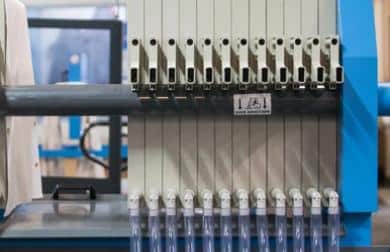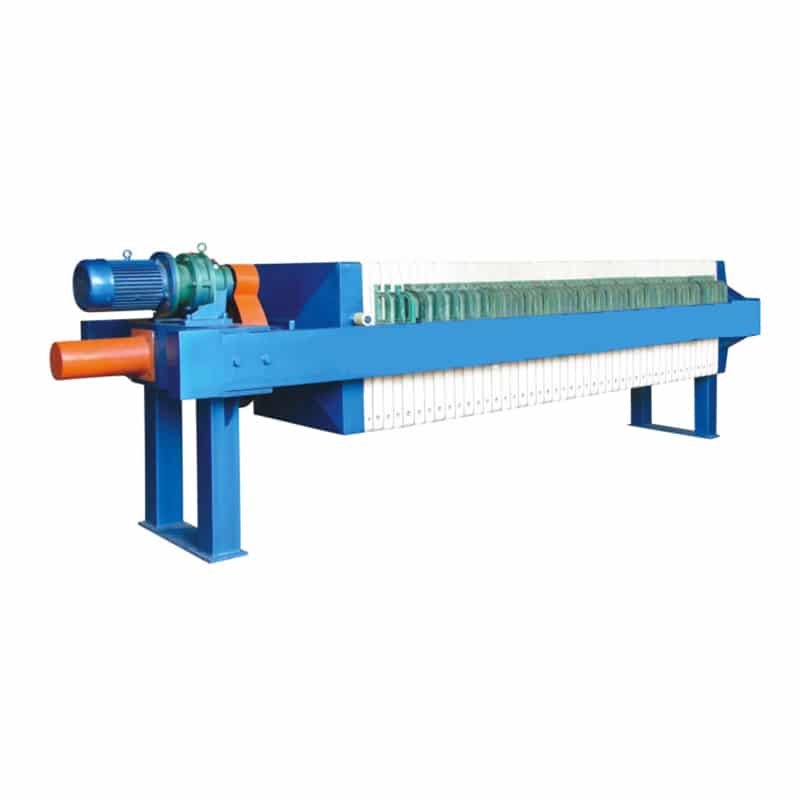In liquid-solid separation, filter press technology has always played a crucial role. Among the many filtration presses, the recessed chamber filter press has become one of the first choices in many industries due to its unique design and efficient filtration performance. In this article, we will discuss the working principle, advantages, and features of the recessed chamber filter pressand its applications in different fields to give you a comprehensive understanding of this important liquid-solid separation equipment.
What’s a recessed chamber filter press?
A recessed chamber plate filter press is a common type of filter press equipment used for solid-liquid separation. It is a type of plate and frame filter press and plays an important role in the solid-liquid separation process.

It consists of a series of vertically aligned filter plates and filter cloth, with a series of recesses (also known as chambers) formed between the plates, which form fixed filter press chambers during the filter press process. When the feed liquid is pumped, solid particles are retained by the filter cloth in the filter press chambers between the recesses, while clean liquid flows out through the filter cloth. The recessed filter press is usually used to process high concentrations of suspended solids, such as sludge, mud, etc. It has the advantages of high efficiency, energy saving, and easy operation.
Filter Plate
The filter plate is one of the important parts that make up a recessed filter press, and it is usually made of materials with a certain degree of strength and corrosion resistance, such as polypropylene and cast iron. The upper surface of the filter plate is usually covered with a filter cloth, which is used to filter solid particles and leave clean liquid. The filter plate usually also has guide grooves or guide holes to guide the feed liquid into the filter press chamber to ensure uniform and stable filter press results.
Areas of Application
- Wastewater Treatment
- Chemical Industry
- Pharmaceutical Industry
- Mining Industry
- Food & Beverage
Features Of Recessed Chamber Filter Presses
- Recessed structure: A series of recessed grooves are formed between each filter plate, which form a fixed filter press chamber for holding solid particles and filtrate during the filter press process.
- Filter plates and filter cloths: The filter plates are covered with filter cloths to filter solid particles and leave clean liquid.
- High filter press efficiency: By increasing the area of the filter cloth and reducing the depth of the filter press chamber, the filter press efficiency is increased and solid-liquid separation is realized.
- Wide range of application: The recessed chamber filter press is suitable for treating all kinds of suspended solids with high concentration, such as sludge, mud, chemicals, minerals, foodstuffs and so on.
- Energy saving and environmental protection: The recessed chamber filter press adopts an automated control system, which can adjust the parameters of the filter press process according to the actual demand and reduce energy consumption and waste discharge.
How does a recessed chamber filter press work?
- Feed stage: First, the mixture to be treated is pumped to the feed of the recessed chamber filter press. This mixture is usually a suspension of solid particles suspended in a liquid medium.
- Filtering Stage: The feed liquid enters the filter press chamber through the feed line of the filter press. The filter press chamber consists of a series of filter plates and filter cloths that cover the plates to form the filter area. As the feed liquid passes through the filter cloths, solid particles are retained by the filter cloths in the filter press chamber, forming a solid residue layer.
- Pressing Stage: When the filter press chamber is filled with the solid residue layer, the filter press begins to apply pressure, usually through a hydraulic system or a mechanical pressure device. The application of pressure causes the liquid in the chamber to be forced through the filter cloth, while the solid particles remain on the cloth to form a solid residue.
- Discharge Stage: When the pressure has been applied to a certain level, the filter press stops feeding and starts discharging. The clean liquid is discharged through the filter cloth, while the solid residue is retained in the filter press chamber.
- Solids Collection: Solid residue accumulates in the filter press chamber until it needs to be cleaned. When necessary, the operator can open the filter press and remove the solid residue from the filter press chamber.
Through this process, the recessed chamber filter press can effectively separate the solid particles from the liquid in the mixture, thus realizing the purpose of liquid-solid separation. This principle of operation makes the recessed filter press an important piece of equipment in liquid-solid separation applications such as the treatment of wastewater, sludge, chemicals, foodstuffs, and more.
Advantages And Disadvantages of Recessed Chamber Filter Presses
Advantages
- Can feed into a large center hole rather than the small openings in the corners of the plate. Large holes in the center of the plate allow the chamber to fill faster and more uniformly, thus reducing the risk of clogging and causing damage to the plate due to uneven pressure. This is especially important for high-solids feed applications.
- Higher feed pressures can be achieved through the concave chamber design. The “frame” or sealing surface of the chamber plate is fully connected to the center web. This prevents the “frame” from bending under high pressure.
Disadvantages
- Although recessed chamber presses offer several advantages over plate and frame presses, one of the disadvantages is the limitation of the cake thickness, which is determined by the depth of the recessed chamber. The recessed chamber plates cannot be easily replaced with wider or narrower frames as is the case with plate and frame presses. This makes the plate and frame design more suited to applications where variation in test sludge cake is important.
- Another disadvantage is filter cloth replacement. The plate and frame design permits the use of a simple overhanging filter cloth, whereas the recessed chamber requires the filter cloth to be hammered (shimmed) into the plate.
Differences Between Filter Presses
| Features | Recessed Chamber Filter Presses | Belt Filter Press |
| Structure | It consists of filter plates and filter cloths to form a fixed filter press chamber. | It consists of filter cloth, roller, tensioning device, etc., forming a continuous filter press belt conveyor system. |
| Filter Pressing effect | Improved filtration efficiency by increasing the area of the filter cloth and reducing the depth of the filter press chamber. | Solid-liquid separation through the retention of solid particles on the filter cloth, the use of conveyor belts to transport solid residues. |
| Operation mode | Relatively easy to operate. | Relatively complex operation. |
| Filtration range | Handles a wide range of suspended liquids. | Suitable for handling powdery materials, granular materials, etc. |
| Maintenance and Repair Costs | High maintenance costs due to regular replacement and maintenance. | Lower maintenance costs |
There are some differences between recessed cchamber filter press and belt filter press in terms of structure, filtration principle, operation mode, filtration range, application area and maintenance cost, etc. It is necessary to choose the appropriate filter press according to the specific application requirements and conditions.
Recessed ChamberFilter Press Filtration Cycle
Once the chambers are filled, the continued arrival of sludge in the recessed filter press causes a deeper and deeper layer of sludge to form on the filter cloth, which increases the resistance of the filtration system and leads to higher pressures. Typically, maximum filtration pressure is reached within 30 to 45 minutes. The duration of filtration may take anywhere from 1 to 5 hours, depending on the depth of the chamber and the filterability of the sludge. The filtration stage is usually controlled by a timer to set the period during which the maximum pressure is maintained, to obtain a final filtrate output of 5 to 10 square meters of filtration surface area per hour with polymer conditioning and up to 20 square meters per hour with mineral conditioning. When the filter pump is switched off, compressed air is used to drain the internal liquid sludge and the filter circuit.

Summary
As an efficient solid-liquid separation equipment, the recessed chamber filter press provides a reliable solution for wastewater treatment and solid material separation in many industries. Through its unique design and reliable performance, the recessed chamber filter press demonstrates outstanding efficiency and effectiveness in handling various types of suspended liquids.
Kuosi specializes in sewage sludge treatment, we not only offer recessed chamber filter presses, but we have a range of plate and frame filter presses, membrane filter press, lab filter presses, small filter presses, and in sludge dewatering we offer paddle dryers, as well as a range of effluent treatment.
